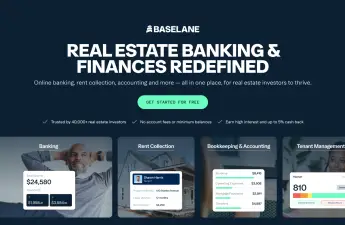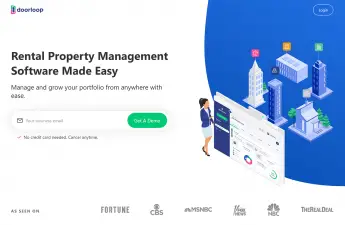As an independent landlord, managing rental properties can be overwhelming. Between marketing units, screening tenants, collecting rent, and responding to maintenance requests, there’s a lot to get done. That’s why choosing the right property management software is key.
At Landlord Gurus, we’ve tested and analyzed the most popular platforms on the market, evaluating them on ease of use, affordability, and features designed specifically for small, independent landlords like ourselves. From the many, we identified the four contenders we believe serve small independent landlords best: TurboTenant, Avail, Zillow, and RentRedi. In this article, we’ll break down our analysis and reveal our top pick.
TL;DR: TurboTenant is our favorite. Read on to learn more.
- Our winner for Best Property Management Software, TurboTenant offers a comprehensive set of property management tools, including advertising, applications, leases, rent collection, maintenance requests, and accounting.
- Strength: Complete Solution
What to Look for in Property Management Software
When evaluating a property management software, here’s what we look for:
- Comprehensive feature set. This includes listing syndication, tenant screening, lease templates, rent collection, maintenance requests, and accounting features.
- Affordability and transparent pricing. As an independent landlord, your budget is limited. Pick a software with reasonable, scalable, and transparent pricing.
- Automations. Think automated rent reminders, bookkeeping, and maintenance workflows. The more the software automates, the less manual work for you.
- User-friendly interface. Navigating your property management platform should be intuitive. A confusing interface brings unnecessary headaches.
- Integration capabilities. Even the best property management platforms don’t have every feature. But some integrate with your favorite tools, such as bookkeeping or maintenance coordination services.
- Scalability. The software should be able to scale with your portfolio. That way, you can avoid the interruption and costs of switching platforms later.
- Customer support and training. Choose a platform with accessible customer support and helpful training so that you can troubleshoot issues quickly.
- Mobile app version. As an independent landlord, you may have another job or other responsibilities. Being able to manage your portfolio on the go can be a lifesaver.
- Security and compliance. Ensure the software adheres to data security standards by safeguarding sensitive property and tenant information.
Top Contenders for Best Property Management Software
Now that you know what to look for in a property management software, here’s a quick overview of the top contenders in our roundup:
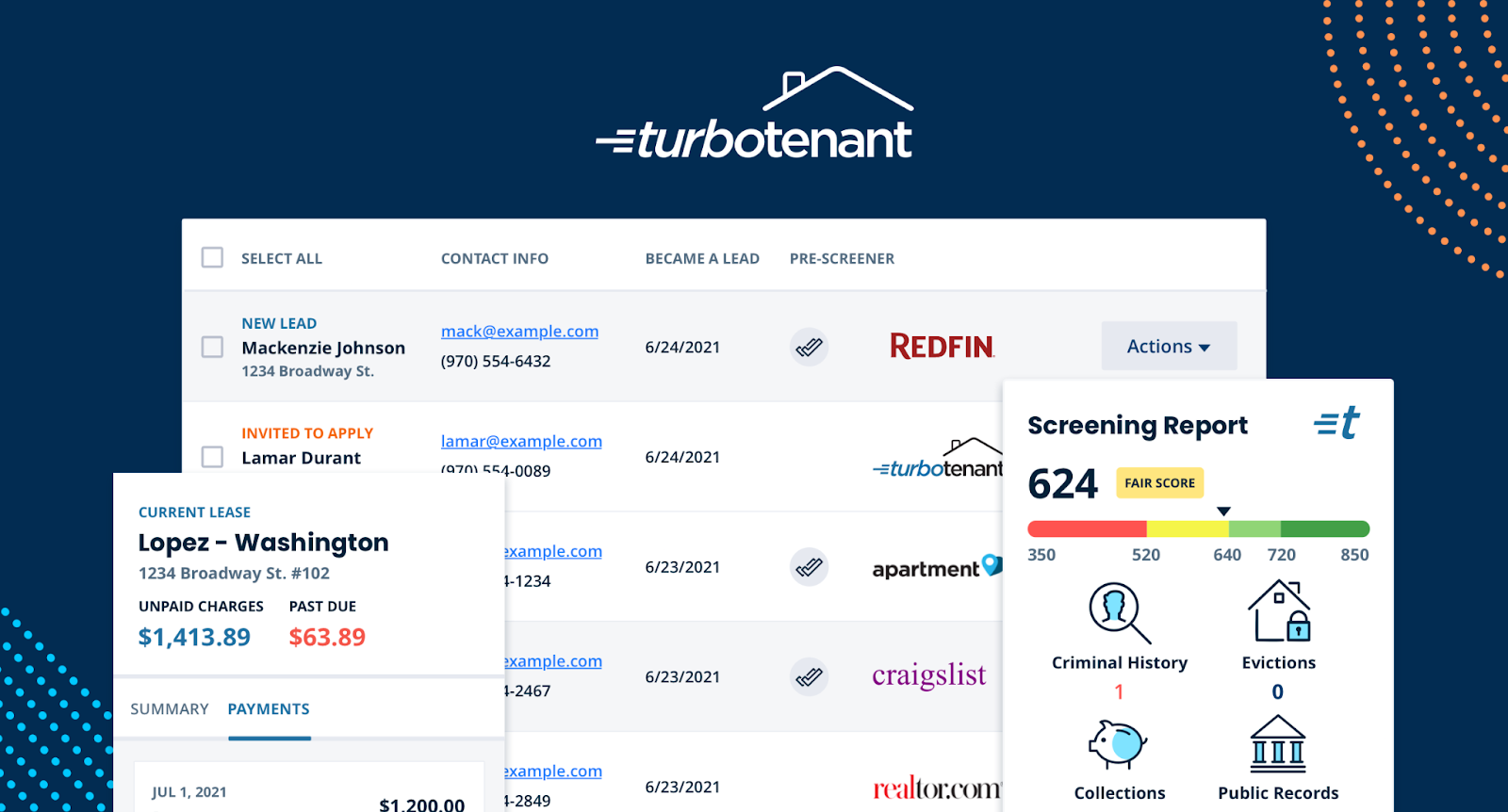
What We Like
- TurboTenant offers a comprehensive set of property management tools, including advertising, applications, leases, rent collection, maintenance requests, and accounting.
- Most features are available for free, with affordable paid plans that cost less than $150 per year and don’t increase with the number of units.
- Tenant screening reports are delivered almost instantly with 99% accuracy and cover credit, background, eviction history, and income verification.
- Listings are automatically syndicated across 25 rental sites, and incoming leads can be pre-screened and scheduled for showings with ease.
- You can customize state-specific lease templates, upload your own documents, accept e-signatures, add co-signers, and include detailed move-in condition reports.
What We Don’t Like
- Payout time for direct deposits is 3-5 days.
- The customer support phone number is only available to Premium users.
- Lease renewal and rent increases can be confusing, requiring confirmation that the term (end date), any changing terms, and new rent amounts are all correct.
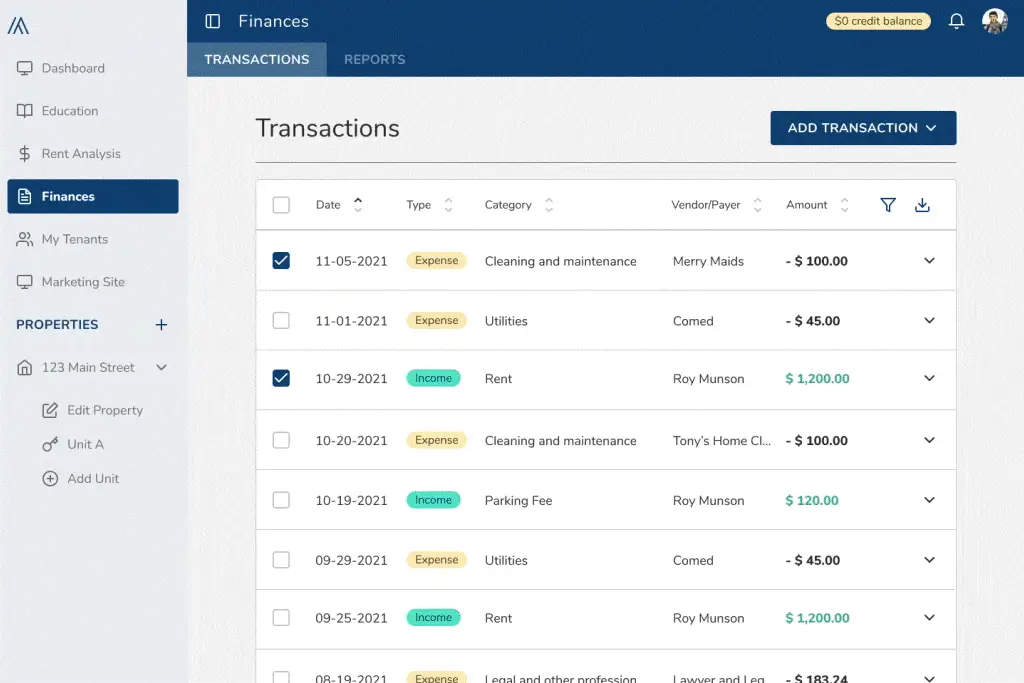
What We Like
- The free plan includes most of the platform’s features, including listing syndication, tenant screening, online rent collection, and maintenance tracking.
- The platform offers 50 state-specific lease templates and e-signing. You can also upload your own leases.
What We Don’t Like
- If you’re on the free plan, rent payments incur a $2.50 transaction fee charged to the tenant. Waiving this fee requires subscribing to the paid plan.
- The paid plan costs $9/unit, which adds up quickly for larger portfolios.
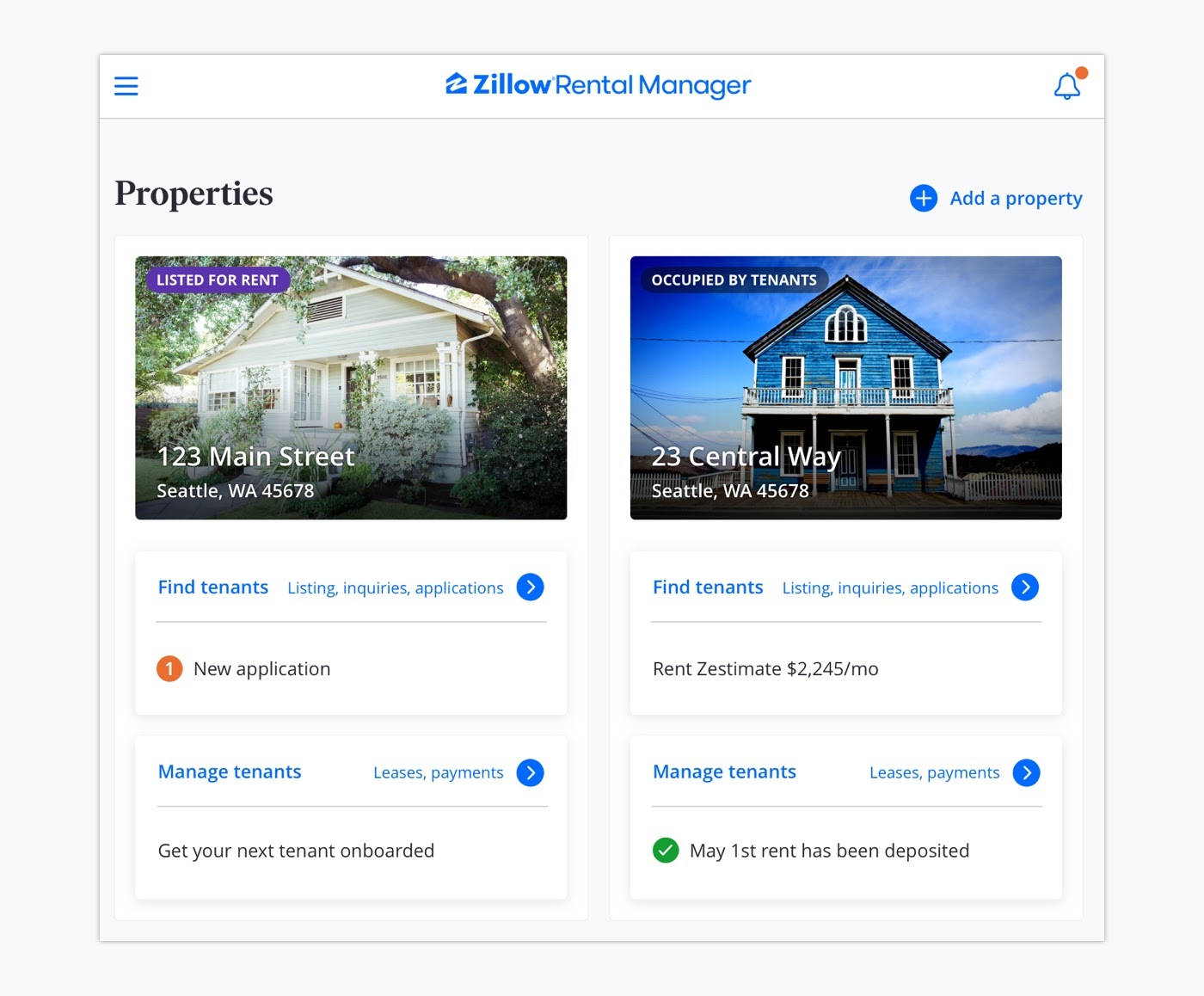
What We Like
- Zillow’s rental listings get wide exposure since many renters use the site to find their next home.
- It’s free to manage your rentals and collect rent on Zillow.
- Zillow offers free state-specific lease templates, plus the ability to upload outside documents and have them signed electronically.
What We Don’t Like
- Zillow pushes its premium listings, which cost $39.99 per listing for 90 days, over regular listings.
- State-specific lease templates are only available for 36 states.
- Landlords can only connect one bank account, so there is no way to direct payments for separate properties to different accounts.
- Zillow covers fewer, more basic features and a narrower set of tools than our other contenders.

What We Like
- RentRedi has convenient, user-friendly mobile apps for landlords and tenants.
- The platform syndicates listings to Realtor.com for free.
- Tenants can pay rent via ACH transfer, debit/credit card, or even cash through RentRedi’s partnership with Chime.
- You can download transaction records in QuickBooks format.
What We Don’t Like
- There isn’t a free version, which means you can’t try the app without paying.
- Syndicating listings to Zillow network sites (Zillow, Trulia, and Hotpads) costs $1.75/day/unit.
- Each rent payment incurs a $1 ACH fee or 3.1% + $0.30 if the tenant pays with a credit or debit card.
- To use RentRedi’s accounting features, you’ll need a paid REIHub subscription in addition to your RentRedi plan.
Our Winner: TurboTenant
Out of all the different property management systems we’ve tried, TurboTenant wins our vote for best platform for independent landlords. Here’s why:
Every Property Management Feature You Need
TurboTenant’s features run the gamut:
- Rental Advertising: Create listings in minutes, syndicate them across 25 rental sites, track and pre-screen incoming leads, message them within the platform, and let them book showings from your custom calendar.
- Online Applications: Collect industry-standard applications with screening reports, add custom questions, verify applicants’ self-reported income by having them upload relevant documents, and send unique application links to renters via text or email.
- Tenant Screening: Control tenant quality by having applicants pay for screening reports that cover credit history, criminal background, past evictions, and income verification.
- Lease Management: Access state-specific lease templates, email them to tenants to e-sign, securely store them within the platform, and upload your own templates.
- Rent Collection: Collect rent and late fees online, allow tenants to turn on autopay, and send them payment reminders and receipts.
- Maintenance Management: Let tenants submit maintenance requests with photos online, assign and track work orders, and fill custom inspection reports for move-ins and move-outs. Add your vendors to the system and loop them in, keeping all communication and records in one place.
- Accounting: Simplify bookkeeping with rental accounting software powered by REI Hub, get real estate-specific financial statements, monitor financial performance with real-time dashboards, and automatically sync transactions with bank accounts.
Affordable Pricing that Scales
You can start using most of TurboTenant’s features for free. The free plan includes unlimited property listings, applications and screening features, online rent collection, work order management, and more. However, you’ll need to pay $59 per state-specific lease, and tenants will be charged a higher screening fee ($55 instead of $45) and a $2 bank transfer fee for each rent payment.
To unlock free lease templates, waived bank transfer fees, and lower screening fees, you can upgrade to Premium for $12.42/month (billed annually at $149). This is a great option for landlords planning to scale since the price isn’t tied to unit count. No matter how large your portfolio grows, the price will stay the same.
Faster and More Accurate Tenant Screening
TurboTenant recently partnered with Rent Butter to provide faster, more reliable tenant screening reports. According to TurboTenant, most of its screening reports—which include criminal background, credit report, eviction history, and income verification—are delivered instantly. When you consider that traditional screening providers take an average of 1-4 days, that’s a huge win that could save owners an average of over $65 per day in otherwise lost rent.
Furthermore, TurboTenant boasts a tenant screening accuracy of 99%. By contrast, most traditional screening providers score an 85.5% accuracy rating, according to a 30-day study conducted by Rent Butter.
Easy Lead Syndication with Wide Reach
Every listing you publish on TurboTenant automatically syndicates to 25 different marketplace partners, including Realtor.com, Rent., Redfin, Homes.com, and even Craigslist. This gives your rentals maximum exposure for attracting tenants.
According to TurboTenant, its users receive an average of 28 leads per listing, and landlords fill units with an average of 20 days.
Automated Pre-Screening and Showing Scheduling
TuboTenant makes it easy to manage incoming leads by keeping them organized in one place. Each lead record includes their name, contact information, date they became a lead, how they found you, and whether you’ve contacted them yet.
You can also set pre-screener questions regarding desired move-in date, monthly income, pet ownership, and smoking status (plus custom questions if you’re a Premium member). This helps you quickly rule out leads that don’t meet your basic criteria. Furthermore, TurboTenant lets applicants schedule showings on a custom calendar that reflects your availability.
According to Multifamily Dive, apartment turnover can cost nearly $4,000 per resident. By establishing a smooth pre-screening and showing process, you can avoid wasting time and resources on unqualified leads.
Versatile Lease Templates, Condition Reports, and Landlord Forms
No matter what state you’re operating in, TurboTenant has you covered with state-specific lease templates that you can customize.
Just fill in who’s on the lease, lease period, monthly rent and due date, security deposit amount, late fee policy, pet rules, and renters insurance requirements. From there, you can add any unique clauses before reviewing the lease and sending it to the tenant for e-signing.
Already have your own lease prepared? You can also upload it to the platform to share and store, just like any other TurboTenant-generated lease.
In addition, you can pair leases with custom condition reports to avoid any “he said, she said” disputes later. Tailor the report to your unit, send it to the tenant to fill and sign, and keep it safely stored with the tenant’s lease.
Lastly, TurboTenant comes with a Landlord Forms Pack that includes 32 common (and customizable) rental forms and notices, such as tenant welcome letters, 24-hour entry notices, lead-based paint disclosures, and more.
Handy Co-Signer Functionality and Workflow
Some tenants may want to add a co-signer to their lease to strengthen their renter profile. A co-signer commits to fulfill all the financial obligations outlined in the lease, alongside the primary signer. These include making timely rent payments, covering any damages or cleaning expenses, and handling any other fees, fines, or charges.
You can add a co-signer when creating the lease. First, have a separate co-signer agreement attached to the lease, and then send the relevant documents to both parties for their e-signatures. This keeps the roles of the tenant and co-signer separate but organized.
Full-Service Maintenance with Lula Integration
On top of letting you accept, assign, and track maintenance requests, TurboTenant can be your full-service in-house maintenance team through its partnership with Lula.
Lula automates your entire maintenance workflow by responding to maintenance requests, dispatching vetted vendors, communicating with tenants, and following up on your behalf. You can even set a “Not to Exceed” (NTE) work order price over which vendors must get your approval before dispatching a job.
Lula is available in over 30 markets with TurboTenant’s Maintenance Plus subscription for $149 per year. The subscription plan covers troubleshooting, scheduling coordination, reviewing the work done, and maintaining a high-quality network of professionals. However, the cost of work carried out is billed separately.
Extensive Toolbox of Integrations, Tools, and Calculators
Over the years, TurboTenant has been busy building partnerships with other landlord services to give users a comprehensive set of tools. The platform’s “Landlord Toolbox” includes integrations with landlord and renter insurance providers, legal services, tax filing services, and more.
Plus, the toolbox includes a free lease agreement AI audit tool and calculators to estimate rent, prorated rent, rental cash flow, rental property ROI, and rent-to-income ratios.
Large Educational Library and Stellar Customer Service
If you ever have questions, TurboTenant has a trove of (mostly free) educational content on its website, including blog and support articles, forums, e-books, webinars, podcasts, and courses.
Plus, you can contact customer support 7 days a week via email and chat. In our experience, the support team is always readily accessible and very helpful, especially if you’re a Pro or Premium member, which gives you faster response times and access to phone support from 8 a.m. to 4 p.m. MT, Monday through Friday.
User-Friendly Mobile App and Notifications
With TurboTenant’s dedicated mobile app (available in the App Store and the Google Play Store), you can manage your properties on the go.
While not every feature is available on the app, many are. For example, you can market properties, manage leads, pre-screen renters, invite renters to apply, request screening reports, and document expenses—all within the app. Plus, it can notify you when you receive a rent payment, application, or screening report.
The Bottom Line
Ultimately, we recommend TurboTenant because it simplifies every aspect of being a landlord—from finding qualified tenants to responding to maintenance requests.
As independent landlords ourselves, we’ve tested a range of tools over the years, and TurboTenant is the platform we trust and use to manage our own properties. It’s reliable, affordable, and built with small landlords in mind.
Take your rental business to the next level by getting started with TurboTenant today.
Disclosure: Some of the links in this post are affiliate links and Landlord Gurus may earn a commission. Our mission remains to provide valuable resources and information that helps landlords manage their rental properties efficiently and profitably. We link to these companies and their products because of their quality, not because of the commission.



